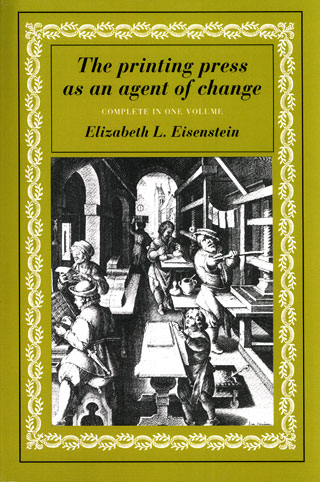Siegfried Zielinski: Deep Time of the Media: Toward an Archaeology of Hearing and Seeing by Technical Means (2002–) [EN, ES]
Filed under book | Tags: · alchemy, art, cinema, electricity, machine, magic, mathematics, media, media archeology, networks, perception, religion, telegraphy, theatre, time, video, vision

“Siegfried Zielinski argues that the history of the media does not proceed predictably from primitive tools to complex machinery; in Deep Time of the Media, he illuminates turning points of media history—fractures in the predictable—that help us see the new in the old.
Drawing on original source materials, Zielinski explores the technology of devices for hearing and seeing through two thousand years of cultural and technological history. He discovers the contributions of ‘dreamers and modelers’ of media worlds, from the ancient Greek philosopher Empedocles and natural philosophers of the Renaissance and Baroque periods to Russian avant-gardists of the early twentieth century. ‘Media are spaces of action for constructed attempts to connect what is separated,’ Zielinski writes. He describes models and machines that make this connection: including a theater of mirrors in sixteenth-century Naples, an automaton for musical composition created by the seventeenth-century Jesuit Athanasius Kircher, and the eighteenth-century electrical tele-writing machine of Joseph Mazzolari, among others.”
Originally published as Archäologie der Medien: Zur Tiefenzeit des technischen Hörens und Sehens, Rowohlt, Reinbek bei Hamburg, 2002.
Foreword by Timothy Druckrey
Translated by Gloria Custance
Publisher MIT Press, 2006
ISBN 0262240491, 9780262240499
375 pages
Reviews: Simon Werrett (Technology and Culture, 2007), Digital Creativity (2007), Simone Natale (Canadian Journal of Communication, 2012), Stephanie Lam (n.d.).
Deep Time of the Media: Toward an Archaeology of Hearing and Seeing by Technical Means (English, trans. Gloria Custance, 2006, 10 MB, updated on 2020-3-24)
Arqueología de los Medios. Hacia el tiempo profundo de la visión y la audición técnica (Spanish, trans. Alvaro Moreno-Hoffmann, 2011, 9 MB, added 2015-6-1 via Will, updated on 2020-3-24)
Peter K. J. Park: Africa, Asia, and the History of Philosophy: Racism in the Formation of the Philosophical Canon, 1780–1830 (2013)
Filed under book | Tags: · africa, asia, china, egypt, empiricism, history of philosophy, idealism, india, pantheism, persia, philosophy, race, racism, religion, science

“A historical investigation of the exclusion of Africa and Asia from modern histories of philosophy.
In this provocative historiography, Peter K. J. Park provides a penetrating account of a crucial period in the development of philosophy as an academic discipline. During these decades, a number of European philosophers influenced by Immanuel Kant began to formulate the history of philosophy as a march of progress from the Greeks to Kant—a genealogy that supplanted existing accounts beginning in Egypt or Western Asia and at a time when European interest in Sanskrit and Persian literature was flourishing. Not without debate, these traditions were ultimately deemed outside the scope of philosophy and relegated to the study of religion. Park uncovers this debate and recounts the development of an exclusionary canon of philosophy in the decades of the late eighteenth and early nineteenth centuries. To what extent was this exclusion of Africa and Asia a result of the scientization of philosophy? To what extent was it a result of racism?
This book includes the most extensive description available anywhere of Joseph-Marie de Gérando’s Histoire comparée des systèmes de philosophie, Friedrich Schlegel’s lectures on the history of philosophy, Friedrich Ast’s and Thaddä Anselm Rixner’s systematic integration of Africa and Asia into the history of philosophy, and the controversy between G. W. F. Hegel and the theologian August Tholuck over ‘pantheism.'”
Review (Carlin Romano, Chronicle of Higher Education, 2014)
Discussion (Warp, Weft, and Way blog, Oct 2014)
Publisher SUNY Press, 2013
Philosophy and Race series
ISBN 9781438446417
237 pages
Elizabeth L. Eisenstein: The Printing Press as an Agent of Change: Communications and Cultural Transformations in Early-Modern Europe (1979)
Filed under book | Tags: · advertising, antiquity, book, cartography, catalogue, censorship, history of science, image, library, literacy, mathematics, media history, memory, philology, print, propaganda, religion, renaissance

“A key text to understand the role of print on social change and the arts. Professor Eisenstein begins by examining the general implications of the shift from script to print, and goes on to examine its part in three of the major movements of early modern times – the Renaissance, the Reformation, and the rise of modern science. Her masterful and well researched text sets a standard for understanding the social impact of printing.”
Publisher Cambridge University Press, 1979
11th printing, 2005
ISBN 052129951, 9780521299558
794 pages
HT Didgebaba
Reviews: Carolyn Marvin (Technology and Culture, 1979), Anthony T. Grafton (Journal of Interdisciplinary History, 1980), Eric J. Freeman (Medical History, 1981), Eric J. Leed (American Journal of Sociology, 1982), Richard Teichgraeber (History of European Ideas, 1984).
PDF (2 vols., 16 MB, updated on 2022-1-30)
EPUB (2nd ed., 2012, added on 2022-1-30)
See also the collection Agent of Change: Print Culture Studies after Elizabeth L. Eisenstein (2007).
Comment (0)
